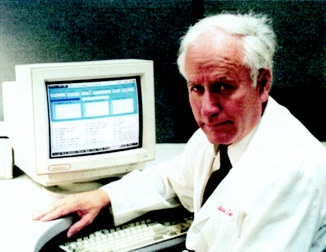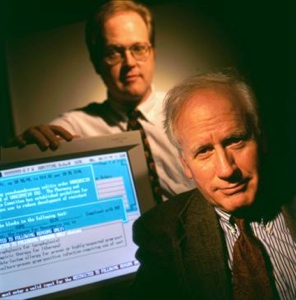




In 1973, Dr. McDonald began creating a rule-based ‘decision support system’ to help caregivers with diagnosis and treatment. This evolved into the Arden system language 15 years later, a standardized mechanism for defining alerts and reminders for caregivers.
(Source: JAMIA)

Paul Dexter, Chief Medical Information Officer, Regenstrief Institute, and Dr. McDonald in 1999
(Source: Regenstrief Institute)
Recognizing the lack of interoperability of patient medical records, Dr. McDonald has, beginning in the 1970s, created a number of new standards and methods in storage and use of medical records for electronic medical assistance. Dr. McDonald developed one of the first standardized inclusive electronic medical record systems, the Regenstrief Medical Record (RMR) System to allow multiple medical systems to make use of all of a patient’s medical history in diagnostics and in help doctors and caregivers with reminders of factors in diagnosis and preventative care (e.g. drug interactions).
In 1973, Dr. McDonald began creating a rule-based ‘decision support system’ to help caregivers with diagnosis and treatment. This evolved into the Arden system language 15 years later, a standardized mechanism for defining alerts and reminders for caregivers.
In 1999, he initiated the development of a medical message (between medical systems) standard - HL7, and is the chair of LOINC, the committee that has created a universal clinical observation coding system, which is being adopted by hospital, testing labs, and government health-care entities.
Dr. McDonald was a founding board member and past president of AMIA, and is Director of the Lister Hill National Medical Center for Biomedical Communications (part of NLM/NIH)